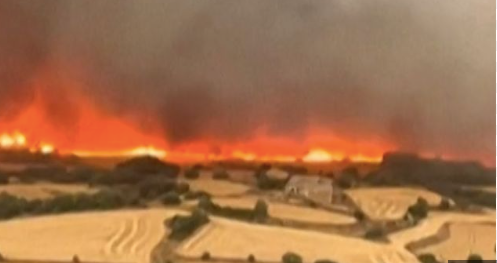A devastating Wildfire in Catalonia, northeastern Spain, has taken the lives of two men as a heat wave grips large parts of Europe. This blaze broke out late Tuesday in Lleida province, quickly spreading across approximately 6,500 hectares of farmland, which is primarily wheat and cereal fields, marking it as the region’s largest recorded wildfire in June. Fueled by relentless temperatures reaching nearly 40 °C and driven by gusting winds, the fire raced at speeds of up to 28 km/h—making it one of the fastest-moving wildfires documented in Europe this year
Catalan authorities confirmed that the two victims, who were a farmer and his worker, were found near their vehicle in the La Segarra countryside. This indicated they were attempting to flee the inferno when tragedy struck. Their deaths came as a painful reminder of how quickly conditions turn fatal in rural regions when nature runs unchecked. 500 firefighters battled tirelessly until late-evening rainstorm helped stabilize flames and contain the spread. These two crew members sustaining injuries were hospitalized in facilities. Residents from bout 14,000 households were ordered to stay indoors for their safety before the order was issued Wednesday morning.
The wildfire aligns with a broader pattern of extreme heat sweeping the continent. Spain and Portugal recorded their hottest June temperatures in over a century, with highs soaring between 40 °C and 46.6 °C in cities like Almería and Mora, respectively. France experienced its own red-alert temperatures of 40 °C+, prompting the closure of nearly 2,000 schools and the temporary shutdown of the Eiffel Tower summit.
Meanwhile, Italy introduced restrictions on outdoor labor to protect workers, as hospital admissions for heat-related illnesses surged. Switzerland went so far as to shut down one of its nuclear reactors to avoid overheating in river water used for cooling—an unprecedented maneuver to safeguard both infrastructure and the environment. Germany, too, faced near-40 °C conditions, triggering forest fire alerts and curtailing school operations .
The death toll across Europe has climbed, with at least eight heat-related fatalities reported: four in Spain, two in France, and two in Italy. In a particularly tragic incident, a young child in Tarragona died after being left in a hot car—a stark reminder of the pervasive dangers of high heat.
Beyond human toll, the environmental damage is catastrophic. Spain’s Mediterranean waters reached record high June temperatures, hampering nighttime cooling and threatening marine ecosystems . Wildfires also ravaged parts of Turkey, triggering mass evacuations and prompting concern across EU member states . In Portugal, earlier flames consumed over 135,000 hectares during last September’s wildfires—a scenario echoed by today’s alarming Spanish fires.
Authorities across Europe implemented various protective measures: France’s high alert in red zones; Italy’s labor protocol for outdoor workers; Spain’s emergency orders on indoor stays; and nuclear plant shutdowns to preserve ecosystems.
In response, the European Commission announced ambitious plans to reduce net greenhouse gas emissions by 90% by 2040—aiming for carbon neutrality by 2050. However, the policy includes flexible mechanisms like carbon offsets, prompting backlash from environmentalists who argue it weakens the initiative’s impact.
Experts warn that such intense heat waves, increasingly frequent due to climate change, require urgent adaptation—like urban cooling solutions, improved fire management, and worker protections. The EU’s new proposals aim to create a more resilient foundation, but local execution will be key.
The loss of two lives in Spain’s wildfire is both heartbreaking and symbolic—a microcosm of Europe’s escalating climate crisis. As extreme temperatures strain infrastructure, endanger lives, and foster uncontrollable fires, countries must enhance fire preparedness, worker safety, environmental policy, and emissions reduction strategies.
This summer isn’t just a warning—it’s a test. Europe’s response now will shape how effectively it confronts the hot, unstable climate future awaiting us. Keep Reading Questiqa Europe for more news.

More Stories
Switzerland Seeks Trade Deal with Trump Without Getting into EU Bind
Venice Locals to Be Moved to Floating Smart Island
Tensions Escalate as Israel Orders Evacuations in North Gaza; Trump Pushes for Peace Deal